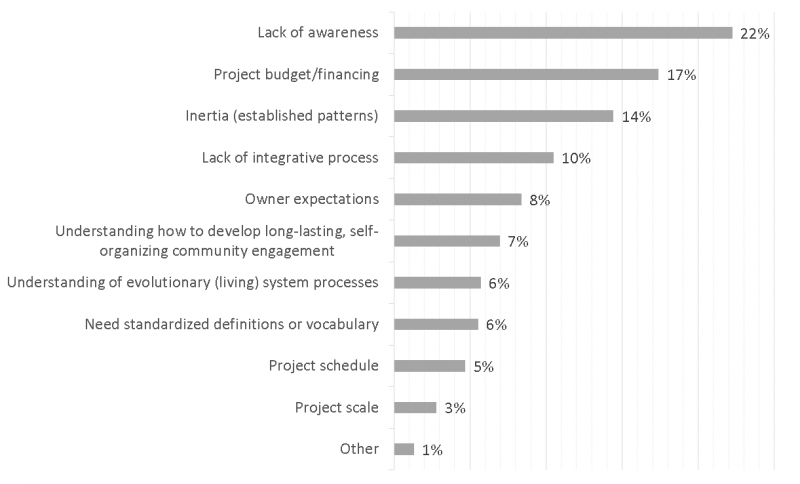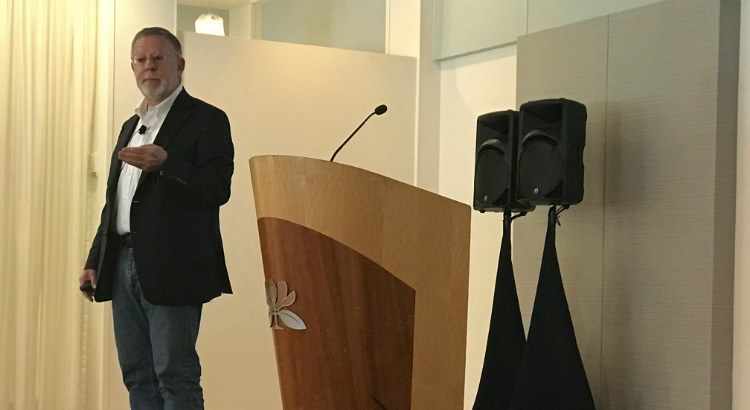Lord Aeck Sargent architect Ramana Koti filed two interesting posts about regenerative design — one before and the other after this month’s U.S. Green Building Council Atlanta summit on the topic.
Among the highlights: In a real-time online survey just as the workshop started, participants ID’d the barriers to regenerative projects. “Lack of awareness” was easily to the top choice.

Koti — who played an important role in materials vetting as part of the design team of the Kendeda Building — also reviews some of the discussion highlights of the summit:
Plenary Session by Bill Reed: Working with potential (evolutionary health of nested living systems) is preferable to working with problems. In other words, harmonize, not compromise. Focusing on problems leads to a fragmented approach whereas focusing on potential has the ability to dissolve problems. Enlarging the scope of seemingly unsolvable problems often shifts the perspective to potential.
Resource Stewardship Panel Discussion: Georgia Tech and The Kendeda Building for Innovative Sustainable Design are making great strides in developing campus-wide sustainability metrics and a net positive approach to energy and water, respectively. Embodied carbon is a harder sell than operational carbon because it is harder to see and to assign monetary value. Whole Building Lifecycle Assessment (LCA) can help to identify a project’s high impact areas. Carbon has time value, and with the pressing need to address climate change, early savings should gain higher priority over long-term savings. Embodied emissions from building materials and construction processes fall in the early savings category whereas operational emissions fall in the long-term savings category.
Biomimicry, Biophilia, and Ecotone Panel Discussion: It is possible to have it all and, at the same time, halve it all by using nature’s efficiency as an inspiration. Nature also has a calming and uplifting effect that puts one in the present moment. Types of diversity to consider are bio, material, and experiential. When you are dealing with a project with too much focus on monetary costs, take the client for a walk in the woods to shift perspective.
Quantification and Metrics Panel Discussion: When it comes to building materials, from a manufacturer’s perspective, action on climate change (carbon footprint) can be the post-sustainability frontier. Energy poverty and energy burden are real problems; there are people who have to skip meals or miss refilling prescriptions in order to pay their utility bills. A strategic combination of energy efficiency and renewable energy has the potential to ease energy burden for the vulnerable.
Interactive Process Workshop: How does a project in Atlanta add value to the larger “whole” (community, city, ecoregion, life-shed, etc.) it resides in and how does the larger whole inform the development of the project? How does one define the bounds of the larger whole? The development of a purpose statement for a project can lead to surprising insights for its approach to regenerative design. Action is informed by strategy, which is, in turn, informed by beliefs and principles.
Read Koti’s full blog post (including a really cool graphic) here. Also a full disclosure: The Kendeda Fund, the publisher of this blog, was a sponsor of the Regenerative Design Summit.
PHOTO ABOVE: Regenesis Group principal Bill Reed speaks at this month’s USGBC Regenerative Design Summit in Atlanta. Photo by Ken Edelstein.


